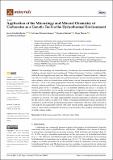Por favor, use este identificador para citar o enlazar a este item:
http://hdl.handle.net/10261/265252COMPARTIR / EXPORTAR:
 SHARE SHARE
 CORE
BASE CORE
BASE
|
|
| Visualizar otros formatos: MARC | Dublin Core | RDF | ORE | MODS | METS | DIDL | DATACITE | |

| Título: | Application of the mineralogy and mineral chemistry of carbonates as a genetic tool in the hydrothermal environment |
Autor: | Carrillo-Rosúa, Javier ; Morales Ruano, S.; Roberts, Stephen; Morata, Diego; Belmar, Mauricio | Palabras clave: | Hydrothermal Gangue Mn Carbonate Spain Chile |
Fecha de publicación: | 29-jul-2021 | Editor: | Multidisciplinary Digital Publishing Institute | Citación: | Minerals 11(8): 822 (2021) | Resumen: | The mineralogy and mineral chemistry of carbonates from various hydrothermal deposits, including volcanic-hosted Au-Cu epithermal, “Chilean Manto-type” Cu(-Ag), stratabound Mn, and Ag-Ba vein deposits from Spain and Chile, were investigated. Dolomite-ankerite (±siderite) was found in variable amounts within the epithermal deposits and associated hydrothermal alteration, whereas calcite was found either within barren veins or disseminated within the regional alteration. Calcite is the major gangue phase within the stratabound deposits, which tend to lack dolomite/an-kerite and siderite. Carbonates precipitated from hydrothermal ore fluids are typically Mn-rich, up to 3.55 at. % in siderite, 2.27 at. % in dolomite/ankerite, and 1.92 at. % in calcite. In contrast, calcite related to very low-grade metamorphism or regional low-temperature alteration is Mn-poor but sometimes Mg-rich, possibly related to a higher temperature of formation. Chemical zonation was observed in the hydrothermal carbonates, although no unique pattern and chemical evolution was observed. This study suggests that the chemical composition of carbonates, especially the Mn con-tent, could be a useful vector within ore-forming hydrothermal systems, and therefore constitutes a possible tool in geochemical exploration. Furthermore, Mn-poor calcites detected in some deposits are suggested to be linked with a later episode, maybe suggesting a predominance of meteoric wa-ters, being not related to the main ore stage formation, thus avoiding misunderstanding of further isotopic studies. | Versión del editor: | http://dx.doi.org/10.3390/min11080822 | URI: | http://hdl.handle.net/10261/265252 | DOI: | 10.3390/min11080822 | Identificadores: | doi: 10.3390/min11080822 issn: 2075-163X |
| Aparece en las colecciones: | (IACT) Artículos |
Ficheros en este ítem:
| Fichero | Descripción | Tamaño | Formato | |
|---|---|---|---|---|
| Minerals_11_ 822_2021.pdf | 6,81 MB | Adobe PDF |  Visualizar/Abrir |
CORE Recommender
Page view(s)
36
checked on 22-abr-2024
Download(s)
156
checked on 22-abr-2024
Google ScholarTM
Check
Altmetric
Altmetric
Este item está licenciado bajo una Licencia Creative Commons

